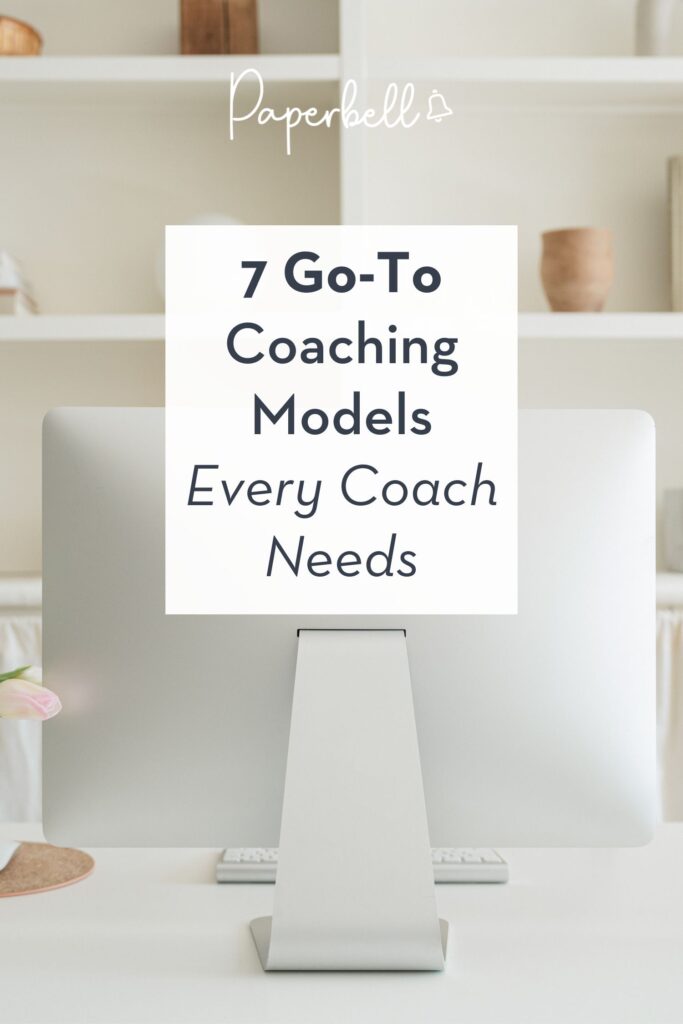Coaching models allow you to explore a specific issue or topic with the client in a structured way.
There are many coaching frameworks for various circumstances and desired outcomes, so let’s explore the most used ones and what differentiates them.
Which Coaching Model Suits My Client?
Different clients may resonate with and respond to different coaching frameworks. Here are some coaching questions you can ask them to find out which one to use:
- What are the specific outcomes you would like from coaching?
- What area of your life or personal development would you like to focus on?
- Do you prefer a more structured or open-ended approach to coaching?
- How do you prefer to receive feedback?
- How would you like to be kept accountable during the coaching program?
- What motivates and inspires you?
- How do you learn and process information best?
Establishing the answers to these questions with your client can give you valuable insights into how they learn and respond to guidance. This information will help you choose the best coaching method for a positive outcome.
Paperbell is the all-in-one tool that runs your coaching business, and it all starts with a beautiful website that screams “professional”. Try it out today for free.
7 Coaching Models for Every Coach
Let’s review the most popular coaching models you can add to your practice.
1. GROW Model
The GROW coaching model, first used by Sir John Whitmore, is the most well-recognized and used coaching framework.
The initials represent the stages of a coaching journey:
- Goal
- Reality
- Options
- Will
Let’s look at them in detail.
Step 1: Goal
If you are on a journey, you need a destination, right? The first step in the GROW coaching model is to know what you want to achieve. That includes the main objective of your trajectory and your short-term desired goal.
The SMART goal framework comes in handy here, which stands for:
- Specific
- Measurable
- Achievable
- Relevant
- Time-bound
When you use this framework to set goals, you break each goal down into achievable chunks. This framework gives the client clarity, motivation, and accountability.
Here are a few questions that help you identify the right goal for the client:
- What will achieving this goal give you?
- How can you be sure that you have achieved what you want?
- What’s the bigger picture for you?
Step 2: Reality
Now that you know your client’s goal, it’s time for a reality check. This can be summed up in one simple question: What’s your client’s current situation in relation to their goal?
Your job here is to help the client evaluate their past progress and identify the obstacles still holding them back. You will need to resolve the issues that come up during your coaching conversations.
Here are a few questions that will help you check in on where your client stands:
- What is happening now in relation to your goal?
- What have you done so far to reach your goal?
- What worked and what didn’t?
- What challenges are you facing?
Step 3: Options
This stage of the GROW model is about helping the client discover the available opportunities. It’s time to generate options for your client to achieve their goal.
You can start with a brainstorming process:
- What would you do if [the problem] didn’t stop you?
- How do others do it?
- What would you do if anything was possible?
- What else do you need to achieve your goal? How can you get it?
- What are the pros and cons of this option?
- What has worked in the past?
Step 4: Will
Once your client has defined their goal, become aware of where they are in their journey, and explored different options, they are ready to choose one and commit to it. Your role as a coach in this step is to help them convert it into a concrete plan of action. What will your coachee do to make their goals a reality?
Here are some questions to help your client wrap up their plan of action:
- Which of these alternatives will you choose?
- What step can you take now?
- How do you expect to overcome your obstacles?
- How motivated are you to follow this plan on a scale of 1 to 10?
In summary, the GROW life coaching model involves asking powerful questions and working collaboratively with your client. You can customize the coaching model to suit their needs while sticking to the sequence of these four stages.
For the best results with the GROW coaching method, you want to make sure the client’s goal is realistic but still inspiring enough so that they want to fully commit to it.
This model works in nearly any coaching niche, from executive coaching, leadership coaching, team coaching, mindset coaching, and more.
2. TGROW Coaching Model
The TGROW coaching model, which was adapted by Myles Downey in his book Effective Coaching, is a variation of the GROW model.
The only difference (the letter T) stands for “topic,” the general area that your client wants to focus on. In this stage, before even defining their goal, you help them see the bigger picture and better understand the topic in question. This may help them uncover underlying issues and reposition their journey.
Use these questions in this stage:
- What would you like to talk about?
- Why is this important to you?
- Why do you need to address this topic?
Asking these questions before the Goal stage will help your client separate the bigger picture from their specific goals. This step will create a solid foundation and prevent your client from setting unrealistic or irrelevant goals.
3. OSCAR Coaching Model
The OSCAR coaching model is a solution-focused coaching methodology. Because of this, it’s one of the most common coaching techniques used in performance coaching. It focuses on solutions rather than on the problem itself.
It was created by two famous coaches, Mark McKergow and Paul Z. Jackson, and published in their book The Solutions Focus: Making Coaching and Change SIMPLE.
OSCAR is an acronym that stands for:
- Outcome
- Situation
- Choices
- Affirm/Action
- Review
Step 1: Outcome
The outcome or objective will help your client determine what they want to achieve with their coaching sessions and their medium to long-term goals.
In this phase, you ask questions such as:
- What do you want to achieve (in this session)?
- How will you know this session has been helpful for you?
- What would make this a powerful conversation for you today?
Step 2: Scaling
Now that your client has a clear picture of their goal, it’s time to evaluate how close they are to reaching their desired outcome using a scale of 1 to 10. One represents the furthest possible from their goal, and ten means that they have already achieved it (or are about to).
Here are some questions that will help you guide the client in the process:
- On a scale of 1 to 10, how close are you to your goal today?
- What have you already accomplished to get this far on your scale?
- How would you know you passed to the next stage of your scale?
Step 3: Choices
Now that you have an idea of where your client needs to be, the next phase is figuring out what they need to get there. The “know-how” is the abilities, knowledge, skills, and qualities that will enable them to reach their goal.
You can use these questions for this stage:
- What skills do you currently have that will help you reach your goal?
- Have you ever done this or something similar before?
- What skill or knowledge has been useful in the past?
- What qualities do you think would be useful to learn?
- What skills come to mind when you think of your goal?
Step 4: Affirm & Action
The affirmation part of the process focuses on what is already functioning well about your client’s actions, abilities, behaviors, and attributes. Then, it’s time to proceed to the “action” part: What steps should be taken to reach their goal?
These questions might make this step easier for your client:
- What is working so far in your efforts to reach your goal?
- What is the next small step you can take?
- What do you need to do to get closer to your goal?
- What do you want to do now to achieve your goal?
Step 5: Review
This is the review part of the process that normally occurs at the end of each coaching session. That is when you assess what your client has achieved, determine what’s changed, and analyze what they need to do next to get closer to their goal.
Some important questions in the review step are:
- What have you accomplished so far?
- What is better now?
- What important steps did you take to make your process successful?
- What effects did the changes have?
- What do you think will change next?
In summary, the OSCAR model is a simple framework that helps people get insights, explore options, create an action plan, and gain accountability. This method encourages clients to take ownership of their goals and take concrete actions to achieve them. The coach’s job is to ask probing questions to help their client take control of their own destiny.
4. CLEAR Coaching Model
Another great framework with a fresh perspective is the CLEAR coaching model developed by Peter Hawkins.
The acronym CLEAR stands for:
- Contracting
- Listening
- Exploring
- Action
- Review
Step 1: Contracting
The first step is an agreement with your client on logistical matters, such as the frequency and duration of sessions, their venue, and the general grounds of the coaching process. After this, you should explore what your client wants or needs from the sessions.
Step 2: Listening
This stage allows the client to share their reality, thoughts, and emotions. This phase is important as it lets them question their beliefs and motives.
During this stage, you should focus on listening and, ideally, not intervene much. You only have to encourage the client to share and guide the coaching conversation.
For that, you should use the four stages of listening:
- Attentive: Give the client your full and undivided attention.
- Accurate: Analyze and understand what the person has said so that the conversation can be paraphrased.
- Empathetic: Demonstrate that you fully understand the feelings of the client.
- Pure: Achieve a complete understanding of the client and articulate what they said back to them.
Step 3: Exploring
After giving the client room to give you as many details as possible, it’s time to explore what is most important. Asking open questions helps the client fill the gaps in their narrative and go deeper.
This can be done in two steps:
- Step 1: Help the client fully understand the real impact of the scenario on themselves.
- Step 2: Challenge the client to think about possible future actions to solve the problem.
Step 4: Action
The focus here is to get the client to agree to the changes needed and internalize their new mindset. Before taking action, they should genuinely consider each potential choice and how it would help them get closer to their goal.
Step 5: Review
This stage of the coaching model involves tracking the client’s success and getting feedback about the session. Let the client reflect on their progress and then ask how they experienced the coaching process.
Here are a few questions you can ask to get honest feedback from your client:
- What did you find beneficial in this conversation?
- What was challenging in this process?
- What would you change in future coaching sessions?
5. CIGAR Coaching Model
Slightly different from the others, the CIGAR model focuses more on the client’s present. The acronym CIGAR stands for:
- Current reality
- Ideal
- Gaps
- Action
- Review
This method has a new approach when it comes to goal-setting. In this coaching model, the client focuses on real events rather than their desired results (i.e., the gaps between the client and their perfect future).
The main feature of this coaching model is that it outlines clear objectives from the offset, along with structure and focus for each coaching session. This coaching style also includes regular reviews and feedback sessions so the coach can monitor progress toward the goal.
When using this method, the coach will typically look at the coachee’s current situation and clarify their goals and expectations. The coaching conversations will then identify the obstacles in the way.
Once these obstacles are identified, it’s easier for you to help generate ideas for solutions. These ideas will lead to the action the coachee needs to take to move from the current state to the desired one.
This method is more collaborative than directive. As the coach, you’ll need to check in regularly to ensure the client is working towards their goal.
6. FUEL Coaching Model
The FUEL model is a structured approach that guides conversations to foster personal and professional growth. It stands for:
- Frame the conversation
- Understand the current state
- Explore the desired state
- Lay out a success plan
This model emphasizes clarity and direction by first framing the conversation to establish goals. It then delves into understanding the client’s current situation before exploring future aspirations. The model helps clients create actionable plans, ensuring clear steps toward achieving their objectives.
7. ACHIEVE Coaching Model
The ACHIEVE model focuses on a comprehensive process to facilitate goal attainment and personal development. The acronym stands for:
- Assess the current situation
- Creative brainstorming
- Hone goals
- Initiate options
- Evaluate options
- Valid action plan
- Encourage momentum
This model starts by assessing the client’s current state and creative brainstorming to generate ideas. It emphasizes goal-setting and exploring various options.
Overall, ACHIEVE is designed to help clients evaluate their choices, craft a viable action plan, and maintain motivation to reach their goals.
FAQ
Can You Use Coaching Frameworks For Group Coaching?
Coaching frameworks and coaching models can be used for any type of coaching program, whether one-on-one or in a group setting.
They have a set structure but are highly adaptable for various coaching scenarios. As long as you have a coach and coachee, they can work.
What is the Most Popular Coaching Model?
The GROW model, which stands for Goal, Reality, Options, and Will, is the most popular coaching model for setting objectives, exploring challenges, and identifying actions.
What is a Coaching Model?
A coaching model is a structured framework that guides the coach and coachees through the process of achieving goals and solving problems.
What’s the Best Coaching Model for me?
No coaching model is right or wrong. It all depends on what thinking process your client best responds to.
You can always pull up this blog post to refresh your memory on the various frameworks that may help them progress in their journey.
As you gain experience, you may mix and match elements from different models or even create your own unique coaching process.
Of course, coaching models are just one of the many ways you can stand out from your competitors and get more coaching clients. The first step is to make sure you have an online “hub” to make it easier than ever for potential clients to find you.
Paperbell is the easiest way to create that “hub”! This all-in-one coaching platform has everything you need to land and coach your clients, all in a single tool. And yes, that includes an easy-to-launch website that you can be proud to share. Get your free website by clicking right here.

Editor’s Note: This post was originally published in May 2023 and has since been updated for accuracy.









